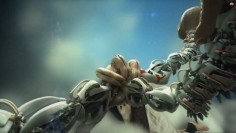AUJIK
Cathexis
via highlike submit

source: 33rdsquare
Inspired by the Technological Singularity movement as described by Vernor Vinge and Ray Kurzweil, and by the ideas and visions of Ben Goertzel, Marvin Minsky and Masahiro Mori, Swedish artist Stefan Larsson creates breathtaking visions of his own in digital film.
Currently living in Japan, Larsson creates film projects such as AUJIK and Cathexis featuring bizarre creatures. Cathexis which is a collaboration with a Scottish electronica musician called Christ and a professor in cognitive neuro science at Stockholm’s university. The theme of the the film is how Artificial General Intelligence (AGI) transcends with nature and the human mind by an esoteric and animistic fictional group called AUJIK.
Cathexis is currently part of SIGGRAPH Asia in Singapore.
Larsson’s work also been part of Prix Ars Electronica, CMoDA Beijing, onedotzero, Japan media arts festival and many more. He has also held solo exhibitions in Tokyo, Osaka and Kyoto where he currently lives.
In his film, the AUJIK are featured. AUJIK are a group of new age Shintos who believe that everything in nature is animated, event the technological, artificial and synthetic. The work evokes Matthew Barney’s Cremaster Cycle in some respects, but more concretely explores the technological.
“One of the main ideas with the AUJIK artefacts is that they don’t have any purpose. They are a kind of entity which are a crossbreed of nature and technology. Everything we consider technology – from the knife to carbon nano tubes -originates from nature and are constructed for a certain purpose to serve our needs.” says Larsson. “All forms of technology also evolve and becoming more efficient. The AUJIK artefacts never evolve, they always been in the same state since the Cambrian Explosion.”
Stefan Larsson Exploring the Singularity
“Their attributes are characterized by an idle and resigned behavior Each artefacts consists of an consciousness and sub consciousness similar to Artificial Intelligence, but with a much more vast and multifaceted capacity. Even though they properly have a very wide emotional register they are unable to express them self in any forms. Considering the importance and demands people have on technology these artefacts might be dangerous to some extent since they are rather redundant and may be looked upon as self indulgent.”
For the last year and a half Larsson has been working on the progressive short film, Cathexis. It is currently 25 minutes and the aim is to make it at least 45 minutes long. Larson says that it is built in chapters with various themes that all have the AUJIK artefacts artificial limbic system (a more complex form of AI) as a core.
The chapters are:
QUALIA: Form, space, physics, mimicry and metamorphosis.
AMYGDALA: the limbic system; neurosis, psychosis, phobias.
LABRIDAE: Gender, animus/anima-complex, hermaphroditism.
MANDALA: creativity, interaction, transcendence.
Stefan Larsson AUJIK
“It is basically about how the group members intend to interact with the artefacts consciousness/sub-consciousness and the results and consequences of that pursuit. There’s so many fascinating aspects of AI that will reveal many new areas of the human mind.”
According to Larsson, “It’s like reverse reverse engineering in a way. In Cathexis is try to manifest some of this vision and ideas in a rather anomalous fashion. Most of the scenes are filmed using green screen which is pretty harsh work since I don’t have access to a green screen studio and have to rebuild it for each shoot. I decided to take a break from it and instead learn more about computer graphics technique. So at the moment I’m working on a 5-7 minutes video which is also an excuse to develop on 3D software and mainly particle systems.”
The theme of the video is primitive computation which is illustrated by a stone and the intelligence potential it poses by its billions of atoms. The video will have a macro kind of endoscope perspective with the camera floating through a landscape of objects similar to neurons, foliage, ikebana, nebulas, organs and robotics.
Larsson, says that, “Media art will emerge explosively in the forthcoming years since the technique became more accessible and cheep, which is important for the artists seeking for new ways to express their ideas.”
.
.
.
.
.
.
.
source: behancenet
Since the late 2000’s, the online presence of mysterious nature/tech cult AUJIK quietly spread across video platforms featuring proposed active members and fabricated histories. These virtual appearances suggested decades-old lineage through theoretical schematics outlining their transgressive mission, citing faux reports arguing the life of inanimate matter and modern forms of animism from fictional anthropologists and philosophers. Animated imagery of organic-mechanical hybrids manifest in Japanese forests amidst cloaked figures is paired with a sonic atmosphere set by Mira Calix, Scottish musician Christ and as well as other electronic artists. “Technology can help nature understand itself,” affirm AUJIK narrators, offering new ideologies reminiscent of Shintoism.
For AUJIK, nature is divided into Refined and Primitive categories. This seperation presents a conflict that is the root of all chaos in the world, and in order to reach a sublime state, AUJIK generates rituals to harmonize the organic and synthetic realms. Refined nature consists of evolved technology such as robotics, artificial intelligence, cybernetics, DNA manipulations, and body enhancements. The Primitive includes fauna, flora, and the Earth itself with its precious stones, minerals, and metals. The pulsating foliage and advanced interfaces that emerge in the biosphere serve as sacred artifacts, visions of a futurist environment. Through crossbreeds of biotic and technological systems, AUJIK’s animism for the Digital Age presents new possibilities for evolution and strives for Post-Human nirvana.
AUJIK’s multi-media works have been showcased in galleries, museums, and festivals worldwide including the Prix Ars Electronica, OneDotZero London BFI 2011 & 2013, SIGGRAPH Asia, CMoDA Beijing, Biwako Biennale 2012 & 2014, and Japan Media Arts Festival.

